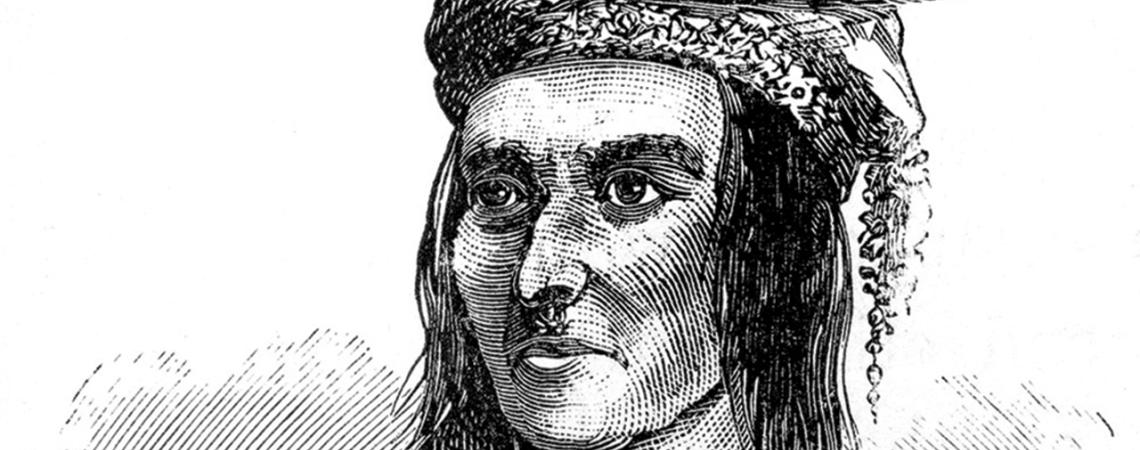Credit: Getty Images
With its tattered seat and uneven slats, the ladderback chair looks rather uncomfortable, but it was pioneer James Galloway’s best chair. “Since this was the ‘guest chair,’ it’s where Tecumseh sat whenever he visited,” says Catherine Wilson, director of the Greene County Ohio Historical Society in Xenia.
Galloway’s chair is one of the world’s few remaining relics of Tecumseh, the great Shawnee leader who desperately tried to save Indian homelands and culture from the tide of white settlement west of the Alleghenies. Though currently on the Historical Society’s campus, the Galloway Log House originally stood near Chalahgawtha (or Chillicothe, one of several villages by that name), the Shawnee tribal capital located by the Little Miami River just north of present-day Xenia. This was the home of the principal chief, Blackfish, when he convened a grand council in 1768 to deal with the problem of whites encroaching on the Shawnees’ Kentucky hunting ground.
As the Kispoko clan chief Pucksinwah and his wife, Methotasa, journeyed to the council, she gave birth to a boy “two arrow flights” away from Chalahgawtha. Since their son’s arrival coincided with the appearance of a bright meteor, they named him “Tecumseh,” meaning “The Panther Passing Across.” A historical marker in Old Town Reserve now indicates Tecumseh’s birthplace.
Tecumseh was born into terror and turmoil. From the French and Indian War through the War of 1812, epic power struggles involving France, Britain, the American colonies, and the young United States spilled into the frontier, where the hunger for land and a clash of cultures provoked vicious cycles of violence and vengeful atrocities.
When Tecumseh was 6, he became Blackfish’s ward after Pucksinwah was killed battling Virginia militia at Point Pleasant. Tecumseh was 10 when the Shawnee held Daniel Boone captive at Chalahgawtha. Although Boone escaped, Kentucky militiamen retaliated by raiding Chalahgawtha. They mortally wounded Blackfish, but the Shawnee caught frontiersman Simon Kenton, who was tortured and almost killed. The next year, Kentuckians looted Chalahgawtha, and when Tecumseh was 12, they destroyed it.
At 26, Tecumseh was among the warriors Anthony Wayne defeated at Fallen Timbers, but he rejected the ensuing 1795 Treaty of Greenville that ceded most of Ohio to the United States. Instead, Tecumseh tried to unite the tribes into a confederacy capable of defending their collective lands. “A single twig breaks,” explained Tecumseh, “but the bundle of twigs is strong.”

By September 1807, Ohio was an up-and-coming state, and Tecumseh had a village at Greenville, where his brother, a religious fanatic known as “The Prophet,” was attracting Indian followers and raising concerns. In Ohio’s first capital of Chillicothe (an erstwhile Shawnee village location), Tecumseh made a speech dispelling whites’ fears of warfare. Afterward, Thomas Worthington, the wealthy “Father of Ohio Statehood,” honored Tecumseh with a banquet at his Chillicothe estate, modern-day Adena Mansion & Gardens. As he had done while visiting Galloway, Tecumseh gave Worthington a tomahawk pipe as a token of peace.
There would be no peace for Tecumseh. He spent years pleading his case for a confederacy to far-flung tribes, acting as both warrior and diplomat to impede U.S. expansion, and earning admiration for his courage, intelligence, and humanity. By 1811, Tecumseh’s multi-tribal stronghold at Tippecanoe Village in Indiana Territory threatened Gov. William Henry Harrison’s land-grabbing ambitions. After The Prophet provoked an attack, Harrison’s army burned Tippecanoe. Tecumseh, of course, sided with the British in the War of 1812, and Harrison’s troops killed 45-year-old Tecumseh in the Battle of the Thames.
Today, towns named for Tecumseh dot the map from Canada to Oklahoma; books, poems, and stories about Tecumseh fill library shelves; museums display Tecumseh sculptures, paintings, and memorabilia; and the U.S. Capitol frieze illustrating significant events in American history features Tecumseh’s death. Only Ohio, however, has Tecumseh!, an outdoor drama performed near Chillicothe, and two historic homes where visitors can retrace Tecumseh’s footsteps.
Indeed, the Galloway Log House still has the limestone fireplace rocks that Tecumseh saw, and original Worthington furnishings have been at Adena since Tecumseh dined there. Equally extraordinary are the Ohio artifacts that Tecumseh himself touched. The tomahawk pipe he gave Worthington is now one of the Adena museum’s most popular exhibits; his Galloway peace pipe graces Fort Ancient’s museum; and in Xenia, the Galloway chair remains a venerable reminder of the legendary native son who bent the arc of American history.









